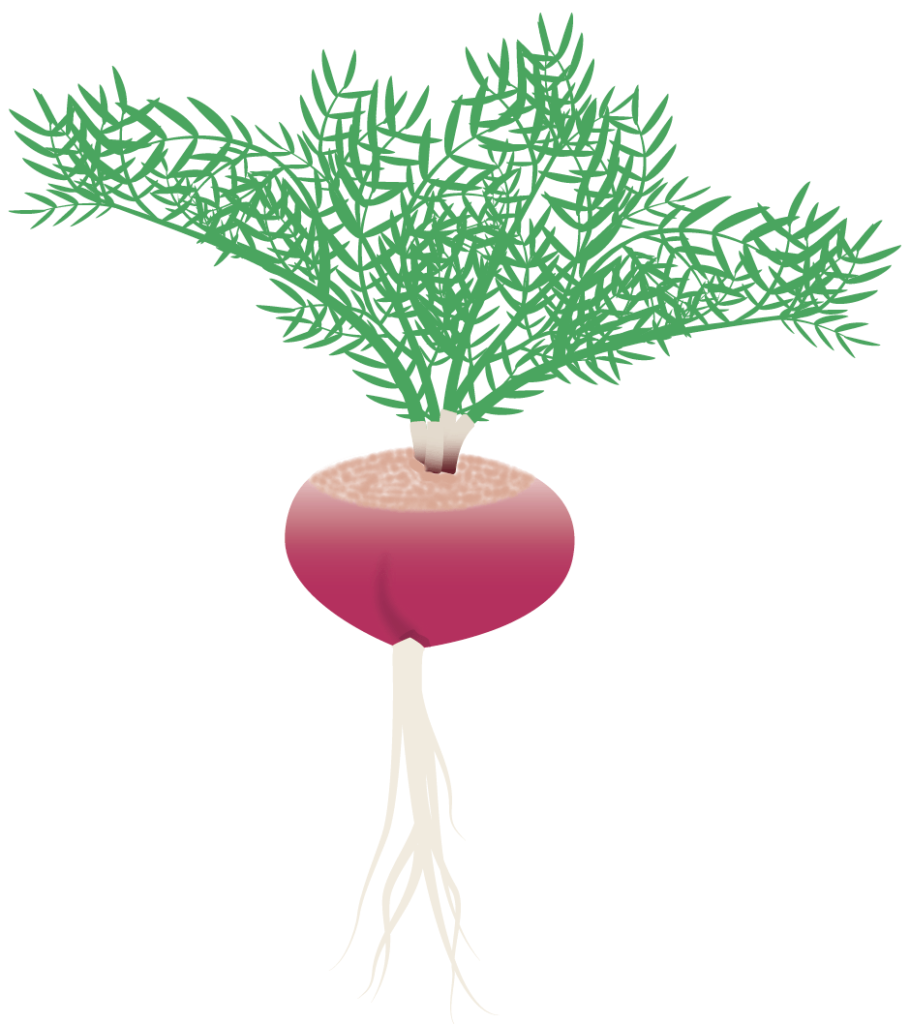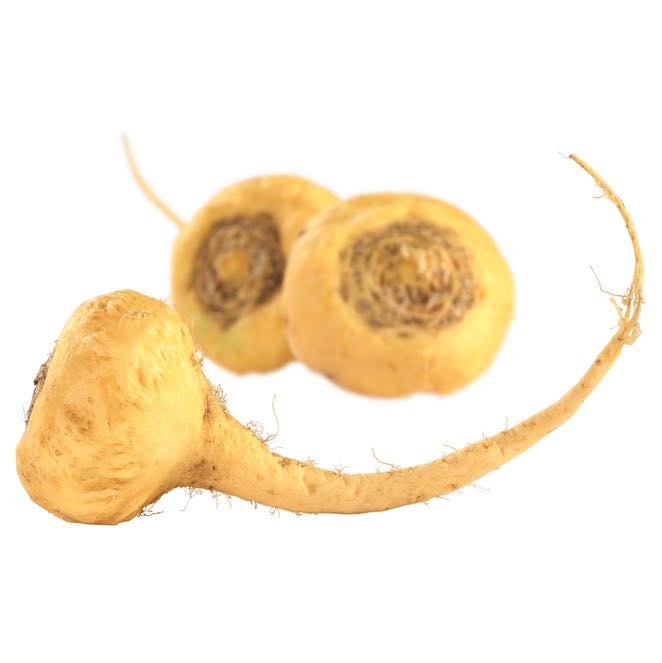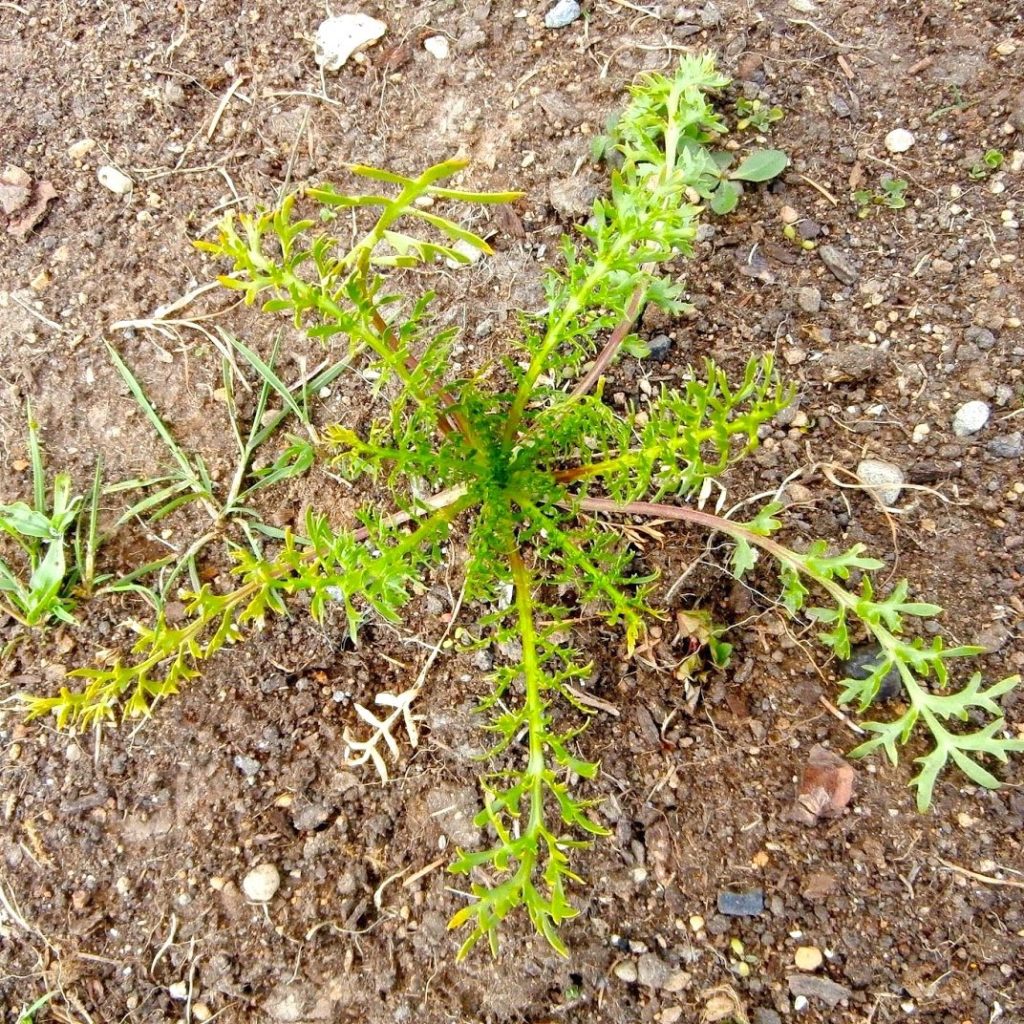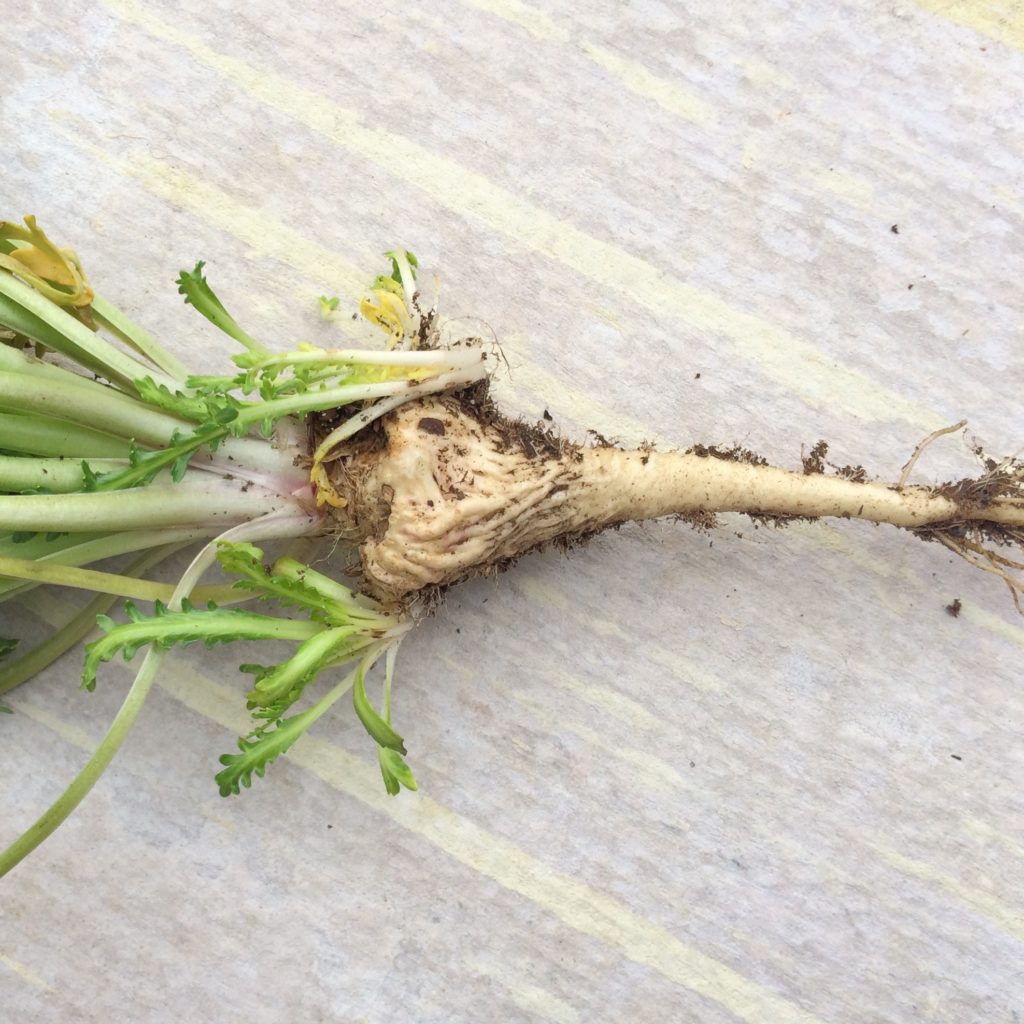 Maca (Lepidium meyenii)
Maca (Lepidium meyenii)
| I am no longer actively breeding or growing maca. There are more crops in the growing guide that I have stopped growing than that I continue to grow. There are many reasons why I stop growing a plant. Often the available genetic diversity isn’t sufficient, the crop does not perform well in my climate, or I just find that I don’t enjoy or make much progress breeding it. Sometimes I come back to a plant later, but you should assume that this crop will not be offered in the store in the foreseeable future. |
Overview
- Maca is a root crop native to the high Andes, close to the upper limit of cultivation.
- This crop is challenging to grow in the Pacific Northwest and very difficult in the rest of the country.
- Maca roots are similar in form to turnips, but smaller, reaching about two to three inches in diameter at most.
- The roots of different landraces are yellow, red, or black (dark purple).
- The roots have a very unusual flavor, something like a combination of radish and butterscotch.
- The leaves of maca are also edible and have a spicy flavor.
- Maca requires a long frost free growing season and grows poorly where summer temperatures exceed 75 degrees.
- The crop is propagated by seeds.
About Maca
Description
Maca (Lepidium meyenii) is a root crop (technically more of a stem crop) that was developed in the Andes. It is sometimes called Peruvian ginseng in English but, as usual, I think we’re better off sticking with more traditional names.
Maca may be the highest elevation food crop in the world; it is grown as high as 4,300m (14,108 feet) in the Puna (NRC 1989). It is grown in the northern Puna of Peru and Bolivia, a region of high elevation grasslands.
The Puna is a difficult environment for crops; it is the region above the tree line, but below the permanent snow cap. Temperatures may range from below freezing to 60° F (16 C) at any time of year. The average temperature range is 40 to 50° F (4 to 10 C). Frosts are frequent during the growing season and the wet season lasts about eight months. Even when the area experiences drought in terms of precipitation, humidity remains fairly high.
Maca is related to many more familiar crop plants. It shares the genus Lepidium with garden cress (L. sativum) and other lesser known edibles. It belongs to the family Brassicaceae, which includes the well-known crucifers, radishes, and horseradish among others.
Maca is grown for its bulbous hypocotyl, similarly to celeriac. The hypocotyl is the lower region of stem between the true roots and the cotyledons (seed leaves). Setting aside the technical information, maca is very similar in form to a turnip or radish. From here on out, I am just going to call it a root.
It is a fairly small plant, rarely growing larger than six inches tall or across. The edible root may range roughly 1 inch to 3 inches (2.5 to 7.5 cm) in diameter at harvest. The leaves are also edible, but rather unremarkable and not abundant enough to justify growing the plant for this purpose. Maca is a close relative of cress and the leaves have a similar flavor. If your maca plants fail to produce good roots, at least you can eat the leaves!

Maca typically has a flavor that is both pungent and sweet. One imaginative description that I have heard is “like a radish dipped in butterscotch”. It isn’t really like that of course, but that probably gives you some idea. Flavor seems to be quite variable with growing conditions.
Although it is technically an annual, it is often grown as a biennial where climate does not allow it to complete its life cycle in a single growing season. It the Pacific Northwest, it requires 5 to 10 months to produce a harvestable root and another 10 to 15 weeks to mature seed (the process is faster in warmer weather). Here, the time to maturity of the roots comprises a normal distribution, centered on 30 weeks. We should all work to shift that toward the earlier maturities by saving seeds primarily from plants that produce full size roots earlier than 30 weeks.
Genetically, maca is an alloploid of octaploid configuration (Quiros 1996). The parent species are unknown. Although it is considered to have low genetic diversity and apparently grows true from seed, the complexity of its genome may reveal more significant diversity if varieties could be crossed. Maca breeding is quite difficult because the plant self-pollinates before the tiny flower buds open, requiring careful work under magnification to circumvent.
History
Maca cultivation extends back at least 2000 years in the Peruvian Puna, with some indications that wild or early cultivated forms were used as early as 1600 BC (NRC 1989). Before the arrival of the Spanish, hundreds of acres of terraced fields may have been planted in maca, stretching from Ecuador to northern Argentina. Today, it is grown primarily in the high elevations around Lake Titicaca.
As recently as the 1980s, maca was considered to be in danger of extinction as a crop plant, but it has made quite a comeback since then. Whether there is anything to it or not, its reputation as a superfood and nutraceutical has increased demand to the point that its future now seems secure. Indeed, Peru and Bolivia now have greater concerns about uncompensated bioprospecting with this crop than they do about extinction.
Nutrition
The roots contain high quality protein and significant amounts of iron and iodine (NRC 1989). Mineral content is often determined at least partly by the soil that crops are grown in, so the iron and iodine content of maca grown outside the Andes should not be assumed.
Fresh maca contains roughly 80% water, 12% carbohydrate, 2% protein, 1.7% fiber, and 0.4% fat.
Maca traditionally has a reputation as an enhancer of female fertility and male virility, a seemingly contradictory combination. It is also said to improve stamina in humans and animals, particularly those affected by high altitude. Its fertility enhancing effects, if they are indeed present in humans, may be caused by isothiocyanate content (Johns 1981). Interestingly, this is the same class of compounds implicated in both increasing female fertility and reducing male virility in mashua!
Maca contains a somewhat higher percentage of glucosinolates than other brassicas. These compounds have been suggested as having a role in preventing some kinds of cancers.
Cooking and Eating
The roots can be eaten raw, like a turnip or radish. They are often pretty spicy, but also sweet. The flavor is unusual, but we think it is delicious.
Maca can also be cooked. Maca roots bake, boil, and roast well. Traditionally, maca is cooked in the pachamanca style: placed in the bottom of a pit in successive layers covered in hot ashes (Leon 1964).
The largest roots are often fibrous. The best tasting, least fibrous roots appear to be those that range from 1 to 2 inches (2.5 to 5 cm) in diameter – about the same size as salad radishes.
Cultivation
Propagule Care
Keep seeds dry and cool. At 60F, maca seeds will retain germination above 80% for two years, falling to about 50% in years 3 and 4, and then dropping off fairly dramatically thereafter. Cooler storage conditions would probably extend life.
Planting
Maca competes poorly with weeds. It is a small, low growing plant that is easily overwhelmed. It its native environment, most of the plants are low and slow growing, so it is poorly adapted for competition with more vigorous lowland plants.
Maca is amazingly tolerant of tough environmental conditions. It can survive poor soils, wind, flooding, drought, cold temperatures, and even surprisingly warm temperatures (into the upper 80s at least). That said, if you want it to quickly form roots with good flavor, it needs consistent water and good soil close to neutral pH with abundant organic matter. Long exposure of mature roots to sodden soil degrades their quality and storage life significantly, so keep maca beds well watered but also well drained.

Learning how to grow every plant is the work of a lifetime, but with maca we’re a lot less far along than others. Maca is so little grown outside of the Andes that growing information is quite limited. We have have started maca during almost every month of the year and had both successes and failures in every case. The best results to date have been achieved by sowing maca in early winter and harvesting in mid summer. In this way, it is similar to garlic in our climate. This will probably not work in USDA zones colder than 7b, where we recommend starting maca in spring once the threat of hard freezes has passed. In warmer climates that do not experience hard freezes, it may be possible to grow maca over the winter, sowing in fall. This growing schedule was used successfully to grow maca in Davis, CA (Hermann 1997). We direct sow here, but starting maca seeds indoors may be preferable in dry climates or where you are trying to produce a crop in a shorter season.
Although maca is not particularly vulnerable to freezing temperatures (we aren’t sure how low it can tolerate, but it has survived overnight lows of 24F here), growth slows considerably in cold weather. Since hypocotyls take up to eight months to reach harvestable size, you should time your maca sowing so that the plant can grow for eight months before cold weather arrives. Here, a March sowing allows for a November harvest. Some plants will go to seed during this time, while others will only set seed the following year. An October sowing will grow slowly through the winter, producing a crop as soon as June in a mild year, after which substantially all of the plants will go to seed.
Maca can tolerate very poor soil. Although soil in the traditional growing areas is quite acidic, maca has been found to perform better in soil of near-neutral pH (Quiros 1996). Make sure that it is not shaded; maca needs a full dose of sunlight to produce a good size root in a reasonable amount of time.
Scatter on the surface of the soil and press into the surface. Germination should take place within two to three weeks. Thin to about a six inch spacing in every direction if supplying regular water or 10 inches in dry conditions.
Maca is a compact plant and will grow very well in a quart-sized pot.
Companion Planting
Maca is generally poorly suited for companion planting as a low and slow growing plant. We are experimenting with cropping it together with garlic and onions but can’t recommend this without more experience.
Harvest
Maca is quite resistant to frost, but hard freezes will eventually kill the tops. That is a good time to harvest the plants. We typically harvest everything and select the largest and best roots for immediate replanting to obtain seed.
Storage
Where the soil doesn’t freeze more than an inch or two, maca is best stored in the ground for fresh eating. If the ground will freeze hard, maca can be harvested and stored at 35 to 38 degrees F and 90% or better humidity for up to two months.
Preservation
Maca is typically preserved by drying the roots, after which they can be stored for several years (NRC 1989). Following harvest, the roots are dried in the sun and then kept in cloth bags for up to two years before the flavor begins to deteriorate. Dried roots are cooked in water or milk to rehydrate and often prepared with some added sweetener (Leon 1964).
Propagation
Unlike many of the other Andean roots and tubers, maca does not appear to have photoperiod dependencies for either root or seed formation. That’s a nice change of pace.

Vegetative Propagation
There is generally little reason to propagate maca from cuttings other than for rapid establishment of clones for seed production when breeding new varieties. In such cases, the plant can be harvested and sectioned like a pie, down through the rosette. Sections are left to heal for a day or two and then planted in damp soil to root.
I accidentally discovered an alternative and perhaps superior way to propagate maca. Maca can be propagated by offsets. If you pull up a maca plant before it flowers and leave it to dry out for a few days, then replant it in very wet soil for 2-3 weeks, it will produce adventitious shoots from the hypoctyl. These can be detached and planted in a sheltered location. Timing is a little tricky. The root needs to dry out and shrivel a bit, but you don’t want the foliage to die, so you need to keep a close eye on the dehydrating plants.
Sexual Propagation
Maca flowers are cleistogamous and seeds generally produce plants that are true to type. This has good and bad features. Cross pollination is not a risk with maca and plants of different varieties can be planted closely. On the other hand, maca breeding is quite challenging because of the small size of the flower buds, which must be opened in order to prevent self-pollination.
Flowering takes place after roughly eight to nine months of growth. Plants should be pulled before the seed capsules are completely dry, or they will shatter. Under favorable conditions, maca plants can set a tremendous amount of seed. We have recovered as much as 10 grams from a single plant, which amounts to some 16000 seeds at 1600 per gram (Hermann 1997).
Maca seed has little to no dormancy and viability drops off fairly quickly after two years.
Problems
We have seen very little insect interest in maca, nor any obvious signs of disease. Birds and rodents both pose a threat, particularly when plants are small.
Pests
Diseases
Defects
Crop Development
The most important development goal for growth in North America is obvious: the production of mature hypocotyls in a single growing season. Since some plants produce good size roots, this doesn’t seem like a particularly difficult task, but our plants have certainly resisted efforts to select a more uniform phenotype. This may be an indication that there is more genetic diversity masked by maca’s polyploid genome than is immediately obvious.
18 thoughts on “Maca (Lepidium meyenii)”
Leave a Reply
You must be logged in to post a comment.

You have a typo here, substituting “oca” for “maca”: “In warmer climates that do not experience hard freezes, it may be possible to grow oca over the winter, sowing in fall.”
Fixed. Thanks for helping to make the site better!
Hello! I would find it very helpful to be able cite your experience (i.e. the maca propagation method) as research info. Could I please get the Author and the date of posting?
Hey Bill, thanks for the wonderful site. I think the “Climate Tolerance” section is either missing or should be removed from the table of contents?
Bill, is this info only about the white varieties? I am interested in growing the red and black maca. Is that available and would it grow in the pacific northwest?
Hi Dora. I grow several colors of maca, but it is hard to get them to set much seed in this climate. That is the main reason why I only offer the yellow type. I’m having a little better luck with a black variety and hope to have enough seed to offer it in the future.
Hey Bill,
I was wondering- do you seem to have weed problems growing maca, and if so how do you combat these?
Also, how much seed can you expect to save from a harvest of say 20 plants of the black variety?
Thanks!
Justin
Maca is not a vigorous plant and competes very poorly with weeds. In its native environment, there is not a lot of competition. You just have to stay on top of the weeding. I find that the red and black maca varieties are very unpredictable seeders, which is why I don’t currently offer them. You might harvest anywhere between zero and 2,000 seeds from 20 plants.
I managed to keep a few Maca growing here in Portugal, but they were very nearly completely gobbled up by crickets. So there’s an insect that can present a threat!
Hello, i have recently purchased 60 black maca seeds. I was wondering, there is any temperature limit, for example if i grow them with led lights, it will be ok? …
Try to keep the soil temperature to 15 to 20 C and they should germinate well. It is often easy to sow them directly outdoors though.
Did you ever get a red or black maca root?
I have both, but I haven’t gotten much of a seed crop the past couple years. If November isn’t too wet this year, I may get a harvest.
So my question is, has it been tried to store the roots over winter similar to carrots, in moist sand, and waiting till spring to replant, rather than planting right away in climates north of 7b?
Yes, that works, but you have to keep them very cold to prevent them from growing – almost freezing.
I’m a Cameroonian and I heard about the MACA root just a few months ago. I’m very interested in the cultivation of the three types ie red, yellow and black. How do I go about getting the seeds here in Cameroon?
Fascinating article. I’m a master gardener in Fresno County, California. I’m thinking about starting an “inside” herb garden since high summer temperatures might prohibit growth here outside. Should I start from seed or use cuttings from roots/leaves? I’m brand new to herbs. Can you help me get started with purchase of seed/cuttings? Thanks.
i want to grow mica plant vegetable in Islamabad Pakistan. it is dry and moist humid, n months of July august. after rainy season in September, it is again dry and hot. rest through out it is dry and hot except for the months of December to February when it is cold. Islamabad is located at33.6844°N 73.0479°E at the edge of the Pothohar Plateau at the foot of the Margalla Hills in Islamabad Capital Territory. Its elevation is 507 metres (1,663 ft).